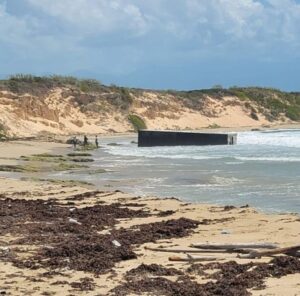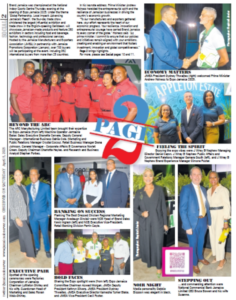Pedro Cays crisis – Garbage pile-up threatens health of 400
THE absence of running water, a lack of toilet facilities and a burgeoning garbage dump threaten to undermine the health of more than 400 Jamaicans who live for months at a time on the island’s Pedro Cays.
“A here so we mek wi little living to maintain our family [and] we nuh really satisfy with it. We looking for improvement; the Ministry of [Agriculture and] Fisheries should intervene,” said fisherman Carl Graham, citing the poor sanitary facilities and an inadequate garbage disposal facility as problems requiring immediate attention.
He was speaking to the Jamaica Observer yesterday during a trip to Middle Cay, one of the three tiny islands that comprise the Pedro Cays. The visit was organised by the Jamaica Environment Trust (JET), with funding from an anonymous donor.
Graham, who has travelled between St Elizabeth and the cays for 19 years, said it was time that something be done to address the public health issues there.
At present, there are only three dirty public toilets on the island, none of them fully functional. A fourth facility was constructed by a business owner on the cay, but that is for her private use only.
Residents have, therefore, had to designate a section of the cay as their own public toilet, leaving in their wake strips of toilet paper and stench. There are those among them who also occasionally defecate in plastic bags, which they toss at sea.
The abundance of garbage, meanwhile, has promoted the breeding of rats, which some residents say weigh up to three pounds, and flies. Up to recently, there were cats on the island, but they had become a nuisance, prompting the authorities to remove them.
“From dem tek out the puss them, a pure rat tek over,” said one fisherman bitterly.
“We have it rough man, very rough,” added Osbourn Reid, another fisher, who lives close to the garbage dump.
He and two of his fellow fishermen said they were at their wits’ end over the management of garbage. They light the dump each night in a vain attempt to keep the waste away from their doorsteps and limit the number of rats and flies.
Still, public health concerns at the cays are not new, as noted in the 2006 draft Pedro Cays Health Assessment report. The document, which identifies the cays as falling under the purview of the Kingston and St Andrew Corporation, referenced a 1996 health assessment, which revealed:
* small, wooden structures with accumulated refuse requiring immediate clean-up;
* severe infestation of bed bugs requiring education and treatment;
* no sanitary convenience on the cays and the use of the northern side of the cay for defecation, requiring the erection of sanitary conveniences; as well as
* gastroenteritis, infected skin lesions, lacerations and trauma requiring education on oral rehydration and condom use.
They also found a lack of tetanus immunisation among fishermen, prompting a recommendation for their immunisation.
The report showed that the clean-up of the accumulated refuse was done, while insecticide powder was distributed to deal with insects and vermin on the cay and a request made for the Storage and Infestation Division to carry out treatment against “bed bugs”.
Since then, the Kingston and St Andrew Health Department has assessed the solid waste issues on the cays, while the vector control team has undertaken “cleaning-up activities as well as rat baiting and spraying for bed bugs, cockroaches and flies (2004)’.
Further treatment for the infestation of flies, cockroaches, bed bugs and rodents was done in 2006. However, this was just a temporary solution “as improvement of the sanitary conditions on the cays is the only real way of reducing the vector problems”, the 2006 report said.
Everton Baker, chief public health inspector with the Kingston and St Andrew Health Department, attested to this when contacted yesterday. It is these measures, he said, that have so far helped to divert a public health nightmare.
However, Baker said a more concerted effort will have to be made to arrest the problems at the cays, which are nationally and regionally significant breeding sites for birds, including the Masked Booby, the Laughing Gull, and the Royal Tern.
“Going forward, there has to be an intervention where things are ordered and managed and there is an institutional framework, like policing on a regular basis — including by people who are regular residents there [who could serve as] monitors,” he told the Observer.
“Also, the persons going there, the licence would have to be tied to a number of agencies, so you have a food handler’s permit and other things. [That way] your licence is a comprehensive one.” Critically, if the garbage problem is to be addressed, he said, there would also need to be a restriction on the items allowed on to the cays.
Permanent Secretary in the Ministry of Agriculture and Fisheries Donovan Stanberry yesterday insisted that the problems affecting the cays were outside the ministry’s scope of responsibilities. However, he said they were, nonetheless, willing to play a role through collaboration with other stakeholders. “…Our responsibility is the management of our fisheries resources out there,” he said.
“[However], the ministry is aware that the conditions out there are not as they should be and we are willing to work with the police, the Ministry of Health, the Kingston and St Andrew Corporation [and whoever else to address the problems],” Stanberry said.
JET boss Diana McCaulay was yesterday shocked at the sheer volume of garbage at Middle Cay. Like the residents, she said Government needed to act quickly.
“When I stand here, I really am saddened by what seems to be a very clear case of governmental failure and neglect,” she said.
“This is a very important natural resource not only for the fish and the birds, but there are several hundred people living here in completely unsatisfactory conditions and I really want to know how it’s been allowed to get to this stage,” McCaulay added.















